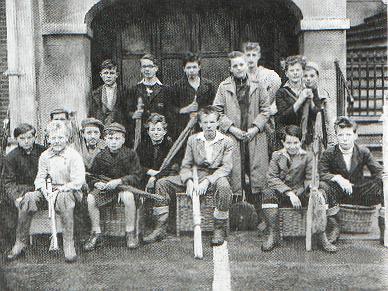|
The Bourne Angling Association Fishing rights along the Bourne Eau were in past centuries under the jurisdiction of the Manor of Bourne Abbots and are frequently mentioned in old documents. In 1753, for instance, the fisheries in the locality, including both the rivers Eau and the Glen, are defined in the will of Edward Presgrave as "the water from St Peter's Pool to Eastcoate to the Cross of Goodroom Coate and the water of Eastcoate or Glen to the Great Stone on the bank at the south east end of the South Fen of Bourne". During the 19th century, they were acquired by the Bourne Fishing Club but this folded in 1887 because of a declining membership and the waters were handed over to the Spalding Fishing Association. In August 1894, these ancient fishing rights were bought for £80 by Mr Thomas Moore Baxter, of Mills & Baxter in West Street, and the following year the Bourne Angling Association [often referred to as the Bourne Angling Society] was formed at a meeting held at the Nag's Head Hotel on Monday 11th March 1895 when Mr Baxter was elected president. He also gave members permission to fish his waters which extended along the Bourne Eau from St Peter's Pool to Tongue End and along the River Glen from Woolley's Mill at Tongue End to Guthram Gowt. Fishing in these rivers was popular during the early part of the 20th century when the angling association flourished and the waters were well stocked with pike, perch, roach and dace that provided excellent sport for club members. A match report from the Stamford Mercury of Friday 20th October 1914, indicated that catches were good at that time: On Saturday, the members of the Bourne Angling Association held a fishing match along the Eau which resulted in an extraordinary catch. The first prize was secured by Mr T Hall with 9lb., against the following other competitors in order of merit: H Rayner 3lb 11oz., H Coxell 3lb. 1oz., S S Baines 2lb. 4oz., E Oliver 1lb. 13oz., F W Keeble 1lb. 12½oz. Mr Hall's biggest fish, a roach, was 1lb. 8oz., while Mr Rayner secured the prize for the largest number of fish. The total of the catch was 28lb. which is the largest in any match arranged by the society. The winner of the first prize has also beaten the previous record for weight which was 7lb., secured in 1903 by Mr J J W Nichols. There was also a junior competition in which J Glover was first with 15oz. and G Frost second with 14oz. The most popular period for fishing along the Eau and the Glen was in the middle years of the 20th century when coaches brought in hundreds of visiting anglers from the Midlands at weekends during the season. On some Saturdays and Sundays, they were spaced out along the banks as far as the eye could see and catches were invariably good. Workers from the processing plant at the Slipe owned by T W Mays and Sons Ltd had a profitable sideline in raising maggots from rotting carcasses and many made their week's wages over again by selling them as bait to visiting anglers during the summer months. When Mr Baxter died in 1920, the fishing rights remained in the possession of his descendants until recent times. The Bourne Angling Association was still in existence in 1965 when there were 270 members and special events during that year included an open competition on the Bourne Eau in aid of cancer research which attracted 200 entries and the river's match record was broken by P Charlton who weighed in with a catch of 36 lb. 2¼ oz. during four hours of fishing.
Fish no longer inhabit the waterway
in such large quantities and although they are returning, especially along
the upper reaches, anglers
do not find the waterway an exciting prospect although the situation may
well change in the near future.
See also The Bourne Eau - a neglected river The Bourne Eau in 1892
The Pike Anglers' Club Fishing in Bourne
Go to: Main Index Villages Index |
